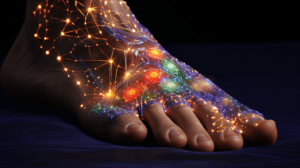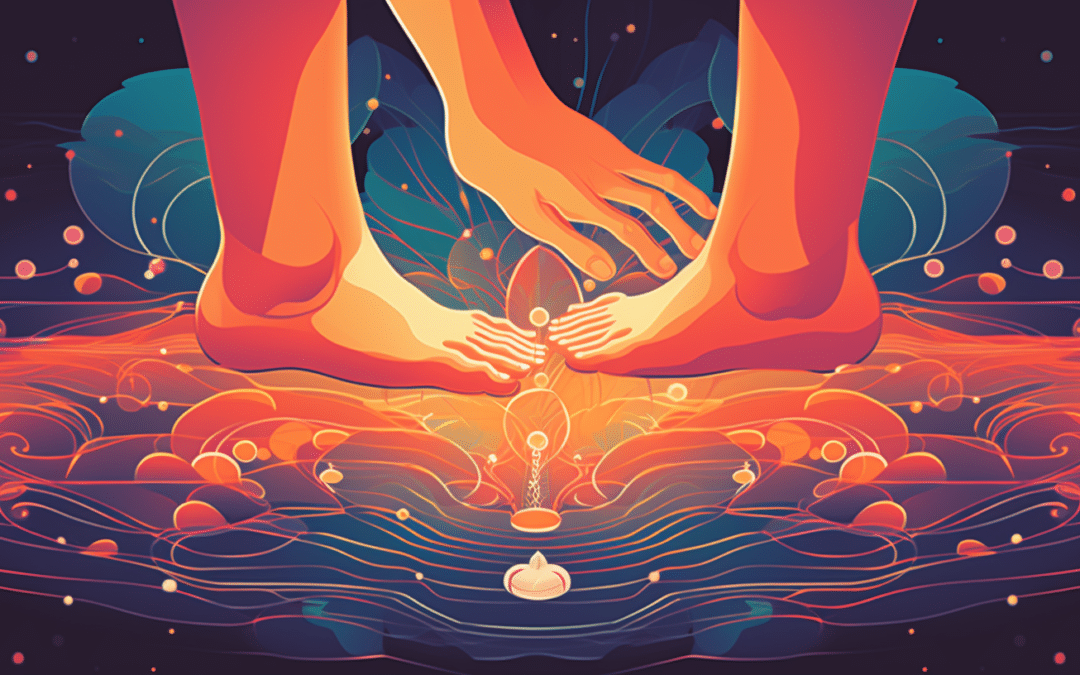With passionate pampering and healing power, massage therapy reflexology is a holistic art used for centuries to promote physical and mental well-being. This ancient technique of pressure and touch can help restore balance in the body by providing relief from pain, improving immunity, and inducing relaxation. In this article, we explore how reflexology works and its impact on modern healthcare about managing pain, improving sleep quality, and enhancing immunity.
Key Takeaways
- Reflexology is a holistic art used for centuries to promote physical and mental well-being.
- Reflexology can help restore balance in the body, improve circulation, reduce inflammation, and promote muscle relaxation.
- Reflexology aids in emotional healing by reducing stress levels, inducing calmness and relaxation, and reducing anxiety and depression.
- Research suggests reflexology can improve circulation, decrease stress and energy levels, enhance mental clarity, and improve immune system functioning.
Understanding the Basics of Reflexology

Reflexology is a therapeutic practice involving applying pressure to certain areas of the body to elicit physiological responses. It is an ancient form of alternative medicine with origins dating back thousands of years. Reflexology benefits stress relief and pain management and provides holistic healing benefits. Through massage therapy techniques such as reflexology, practitioners believe that particular points on the feet are connected to other body parts and can help promote healing and relaxation.
The practice utilizes touch-based therapies to relieve stress, reduce inflammation, improve circulation, and balance energy levels throughout the body. In addition to its physical benefits, reflexology may also have psychological benefits by helping people relax profoundly and find greater clarity in their lives.
Through massage therapy techniques such as reflexology, practitioners offer their clients a safe and effective way to release tension from their bodies while simultaneously gaining access to deeper levels of relaxation. Its healing power lies in its ability to provide physical and emotional relief from various ailments, including headaches, chronic pain conditions, digestive issues, sleep disturbances, and more. Incorporating massage therapy techniques like reflexology into one’s self-care routine can help bring balance and harmony back into one’s life while offering numerous health benefits.
Unlocking the Benefits of Reflexology

Applying specific pressure to certain body points can unlock various health benefits. Reflexology massage is an ancient form of bodywork that combines relaxation techniques with therapeutic massage for stress reduction and pain relief. Through reflexology, practitioners target specific areas in the body by applying focused pressure to corresponding points on the foot. Muscle relaxation and tension release can occur by stimulating these areas, improving circulation, flexibility, and overall health.
Foot reflexology is especially beneficial for those suffering from chronic pain or fatigue as it helps restore balance within the nervous system. In addition to providing physical relief, this practice has been known to aid in emotional healing by reducing stress levels and inducing a deep sense of calmness throughout the body. Furthermore, regular exercise can reduce anxiety and depression and promote peace and well-being.
Ultimately, reflexology massage can treat many ailments holistically while helping individuals become more mindful of their bodies. With its ability to simultaneously provide mental and physical relief, this holistic approach offers people an effective way to manage their wellness needs without relying solely on medications or other drastic treatments.
Decoding the Research on Reflexology
Recent research has sought to evaluate reflexology’s efficacy on various health conditions. Holistic therapy involves applying pressure to specific areas of the feet, hands, and ears to promote natural healing, health, and wellness. Reflexology is often used in a comprehensive relaxation therapy program, aromatherapy, and deep tissue massage. Research has suggested that reflexology benefits may include improved circulation, decreased stress levels, improved sleep quality, reduced pain levels, increased energy levels, improved mental clarity, and enhanced immune system functioning.
These findings point to the potential therapeutic value of reflexology for individuals looking for an alternative or complementary approach to healthcare. Additional research is needed to explore further the effectiveness of this form of holistic therapy on various medical conditions; however, it appears that there are numerous potential health benefits associated with reflexology for those who wish to explore its healing power.
Safety Measures and Precautions in Reflexology
When considering reflexology, it is essential to consider safety measures and precautions. Massage and Reflexology therapies are non-invasive treatments that can promote relaxation, better blood flow, improved circulation, and relief from pain. However, it is still essential to be aware of the potential risks associated with these therapies. These include:
- Swedish Massage: The therapist needs to use appropriate techniques during a Swedish massage, such as avoiding too much pressure on specific body areas or using incorrect postures when performing the massage.
- Shiatsu Massage: When performing shiatsu massage therapy, it is essential not to apply excessive force to avoid skin injury or bruising. Additionally, it is recommended to avoid using direct pressure on bones or joints to prevent damage or discomfort.
- Trigger Point Therapy & Acupressure Massage: Trigger point therapy and acupressure massage must be performed carefully so as not to cause any damage or discomfort due to excessive pressure applied at specific points on the body’s energy lines (meridians). Also, Thai massage must be conducted with care since incorrect postures can lead to strain on muscles and ligaments, which could result in injury if not done correctly.
Reflexology therapy should always be conducted by a qualified practitioner who understands how each technique works and which safety measures should be taken for each type of massage therapy. This ensures that clients receive a safe and effective treatment suitable for their individual needs while providing optimum health benefits from reflexology for health purposes.
Comprehending How Reflexology Works
Reflexology is an ancient healing practice that involves applying pressure to specific points on the feet, hands, and ears to stimulate the body’s natural healing response. It is a form of massage therapy based on the idea that energy pathways or channels connect all parts of our body. By stimulating these pathways through reflexology techniques like sports massage and lymphatic drainage, circulation improvement and energy flow can be achieved, leading to chronic pain relief and wellness benefits such as improved physical and emotional well-being. Reflexology works by targeting specific areas of the feet that correspond to different organs in the body; when pressure is applied to these areas, it helps to restore balance within the body’s systems and promote its overall well-being. In addition, it can help improve blood flow throughout the entire body while also providing relaxation for both mind and body. Reflexology is becoming increasingly popular among those seeking holistic forms of physical therapy due to its ability to bring about deep physical peace while promoting emotional well-being.
Effect of Reflexology on Mental Health
The effect of reflexology on mental health has been studied in depth, with research suggesting that it may positively influence mood and emotional well-being. Reflexology is a holistic practice that engages the mind-body connection, allowing for increased mental relaxation while reducing muscle tension. It is often used as a stress management technique, providing therapeutic benefits to those suffering from anxiety or depression. Reflexology can also be used to treat chronic pain through its healing properties and pain reduction abilities.
Reflexology works by activating specific pressure points around the body, which correspond to different organs and parts. By applying targeted pressure to these areas, reflexologists can stimulate nerve endings tension, increase circulation, and induce relaxation within the body. This can have a beneficial impact on physical and mental well-being alike, leading to improved moods as well as better sleep quality.
Reflexology has demonstrated robust results in managing stress levels and improving psychological health. Combining massage therapy with reflexology provides individuals with pain management techniques that can help promote positive mental health outcomes over time. In this way, we can see how reflexology offers an effective form of healing that enables people to enjoy more fulfilling lives free from stress or discomfort.
Role of Reflexology in Pain Management
Research has demonstrated that reflexology may be beneficial in pain management. This holistic approach to wellness can help individuals living with chronic pain or acute injuries to reduce inflammation, restore balance, and support healing. Self-care practices such as mindful healing and relaxation response techniques can be combined with reflexology massage techniques to promote well-being and start a journey towards pain-free living.
The practice of foot massage in reflexology involves the application of pressure to specific points on the feet that correspond with different organs in the body, known as reflex zones or reflexology points. Utilizing massage therapy benefits such as a soothing touch and various massage therapy techniques can stimulate these areas to relax tight muscles and promote natural relaxation. Reflexology for stress relief has also been found to reduce anxiety levels and increase energy flow throughout the body for enhanced physical performance.
Holistic pain relief strategies through massage therapy involve applying pressure on reflexology points using various reflexology techniques, including kneading, rolling, pressing, vibrating, tapping, stretching, pulling movements, and rotations at different angles. Massage for well-being effectively promotes health holistically by stimulating circulation within the body’s natural systems while easing muscle tension. By combining all these elements into a wellness lifestyle, individuals can experience excellent emotional stability while managing their pain more effectively with holistic healing methods such as foot reflexology massage.
Reflexology and Sleep: A Deep Connection
Reflexology is a holistic health practice used for centuries, utilizing precise touch to bring the body back into balance. It works on the basis that some regions of the feet, hands, and ears correspond to other parts of the body. This ancient natural healing method addresses not only physical symptoms but also emotional issues as well.
The connection between reflexology and sleep is solid; when it comes to promoting restful sleep naturally, reflexology can be beneficial. We can restore our mind and body balance by stimulating specific points on the feet or hands related to our nervous system. Drawing upon its ability to promote relaxation and reduce tension, this practice can provide much-needed relief from insomnia and other sleep disturbances:
- Holistic Wellness Solutions: Reflexology helps us access deep levels of relaxation necessary for a good night’s sleep while relieving stress and anxiety.
- Mindbody Healing: Working with pressure points associated with our respiratory system can help us breathe more deeply while calming down our racing thoughts.
- Health & Balance: By restoring energy flow throughout the entire body, we allow it to heal without drugs or artificial stimulants – leading to improved overall health & well-being.
Exploring Reflexology’s Impact on Immunity
Studies have shown that reflexology can positively affect the body’s immune system. The practice of reflexology is based on the belief that areas of the feet, hands, and ears correspond to specific organs and systems in the body. Stimulating these points through massage can help to restore natural balance and harmony within an individual’s body, mind, and spirit. Reflexology is often used as an integrative therapy or alongside other complementary medicine practices to promote holistic wellness journeys for those seeking natural remedies for physical well-being.
The connection between stress reduction and improved immunity has been well-documented. Studies have found that regular reflexology sessions are associated with improved immune function by reducing cortisol levels and promoting relaxation. This mind-body harmony helps individuals better cope with environmental stressors that would otherwise weaken their bodies’ defenses against disease-causing agents.
Reflexology has also been linked to increased vitality due to its ability to reduce fatigue, improve circulation, and increase mental clarity – all of which contribute to overall physical well-being. As part of a healthy lifestyle characterized by balanced nutrition, exercise, adequate restful sleep, stress-free living, and healing modalities such as reflexology – individuals may find themselves more resilient toward illness while achieving more excellent emotional stability.
The Relevance of Reflexology in Modern Healthcare
As modern healthcare continues to evolve, reflexology has become increasingly relevant as a complementary treatment option for individuals seeking holistic wellness. It is a natural healing practice that has been used for centuries to help relieve physical and mental stress. Reflexology focuses on applying pressure to specific nerve endings in the feet, hands, and ears that correspond with different body parts. Through this method, practitioners can identify areas of tension or discomfort and provide relief through massage therapy techniques such as kneading, pressing, and stretching.
Reflexology can be highly beneficial for those struggling with chronic pain or stress-related issues since it provides an alternative way of managing symptoms without relying solely on medication. Research has found that reflexology can help improve circulation, reduce inflammation, and promote relaxation while providing pain relief strategies such as improved mobility. Additionally, reflexology can support self-care for pain management by promoting mind-body peace, leading to increased mental clarity and natural stress relief practices that allow people to take control of their health journey.
Frequently Asked Questions
How Much Does a Reflexology Session Typically Cost?
The cost of a reflexology session can vary significantly depending on factors such as the practitioner’s experience, location, and session length. Generally speaking, most reflexologists charge an hourly rate that ranges from $50 to $150 per hour. Some practitioners may also offer package deals or discounts for multiple sessions. It is essential to remember that price should not be the only factor when considering a reflexology therapist; focus should also be placed on their qualifications and expertise.
What Is the Difference Between Massage Therapy and Reflexology?
Massage therapy and reflexology are both forms of manual therapy, but they differ in their approaches. Massage therapy typically involves a therapist using their hands to manually apply pressure to the body’s muscles, tendons, ligaments, and other tissues. Reflexology, on the other hand, is based on the idea that areas on the feet, hands, or ears correspond to specific parts of the body, and thus, applying pressure to these areas can help address health issues associated with those particular areas. Both therapies can be part of a healing process for many physical ailments.
Are There Any Contraindications to Reflexology?
Although reflexology is generally considered a safe practice, specific contraindications exist. Pregnant women should be aware of any risks associated with the procedure due to potential hormonal imbalances that could affect their unborn child. People suffering from acute injuries such as fractures, sprains, or open wounds should also avoid reflexology until their condition has improved. Additionally, people taking strong medications may experience adverse reactions when receiving a reflexology treatment. These individuals need to consult with their doctor before undergoing reflexology treatments. Reflexology can offer numerous health benefits, but practitioners must remain mindful of potential risks and contraindications to provide safe and effective care for all clients.
What Type of Qualifications Should I Look for in a Reflexology Practitioner?
When selecting a reflexology practitioner, it is essential to ensure they are qualified and experienced. Look for practitioners who have completed an accredited course or hold a relevant certification from a recognized professional body. Additionally, ask about their experience in the field and any additional qualifications they may have, such as advanced training courses or workshops. Generally, seeking out a practitioner with at least 3-5 years of experience in the field is beneficial. Furthermore, check if they carry insurance and abide by ethical codes of conduct set forth by their governing body. These steps can help ensure you receive quality care that best meets your needs.
Does Reflexology Have Any Long-Term Health Benefits?
Reflexology may hold the key to long-term health benefits. By stimulating the body’s natural healing processes, reflexology can help reduce stress and tension, improve circulation, increase energy levels, and promote overall well-being. Through its use of symbolic touch points on the hands and feet connected to different areas of the body, reflexology helps restore balance in our lives so that we can better connect with our physical and emotional needs. With regular practice, this holistic approach has been proven to improve moods, more restful sleep patterns, and even relief from chronic pain.
Conclusion
Reflexology is a form of therapy that works with the pressure points in our feet and hands to reduce muscle tension, regulate blood pressure, and produce natural painkillers in the body. During a session with a skilled therapist, clients often experience a deep relaxation that helps them manage the stresses of daily life. The calming effects of regular massages can also help improve overall well-being.
Finding a skilled massage therapist trained in the practice is essential to get the most out of reflexology. A qualified therapist can access the most critical reflexology points and provide the proper pressure level according to the client’s needs. They will also be able to offer advice on using reflexology as part of a holistic approach to health and well-being.
The potential of reflexology as a healing modality is only beginning to be understood. As research continues to uncover its benefits, it is becoming increasingly clear that reflexology can be an invaluable tool for improving physical, mental, and emotional health. For those looking to reduce stress and enjoy better sleep, regular massages by a skilled therapist may be just the thing to help them reach a state of deep relaxation and renewed energy.

